BSBMGT502 Manage People Performance: Case Study on HR Misconduct
VerifiedAdded on 2023/04/06
|6
|1070
|444
Case Study
AI Summary
This case study analyzes a scenario involving Sam, a programmer who was unfairly dismissed from an Australian security company due to alleged misconduct and poor performance. The company failed to provide documented evidence of Sam's performance issues and the steps taken to support her, leading to a successful unfair dismissal case against them. The analysis highlights the importance of documenting performance reviews, coaching sessions, and disciplinary actions. It also discusses relevant legislation such as the Fair Work Act 2009 (Cth) and Australian Consumer Law. The study proposes implementing policies and procedures for performance review and disciplinary hearings, emphasizing the need for thorough investigation, documentation, and fair treatment of employees to mitigate future risks and avoid legal repercussions. The case underscores the significance of adhering to legal requirements and internal policies to ensure fair and lawful employee management practices.
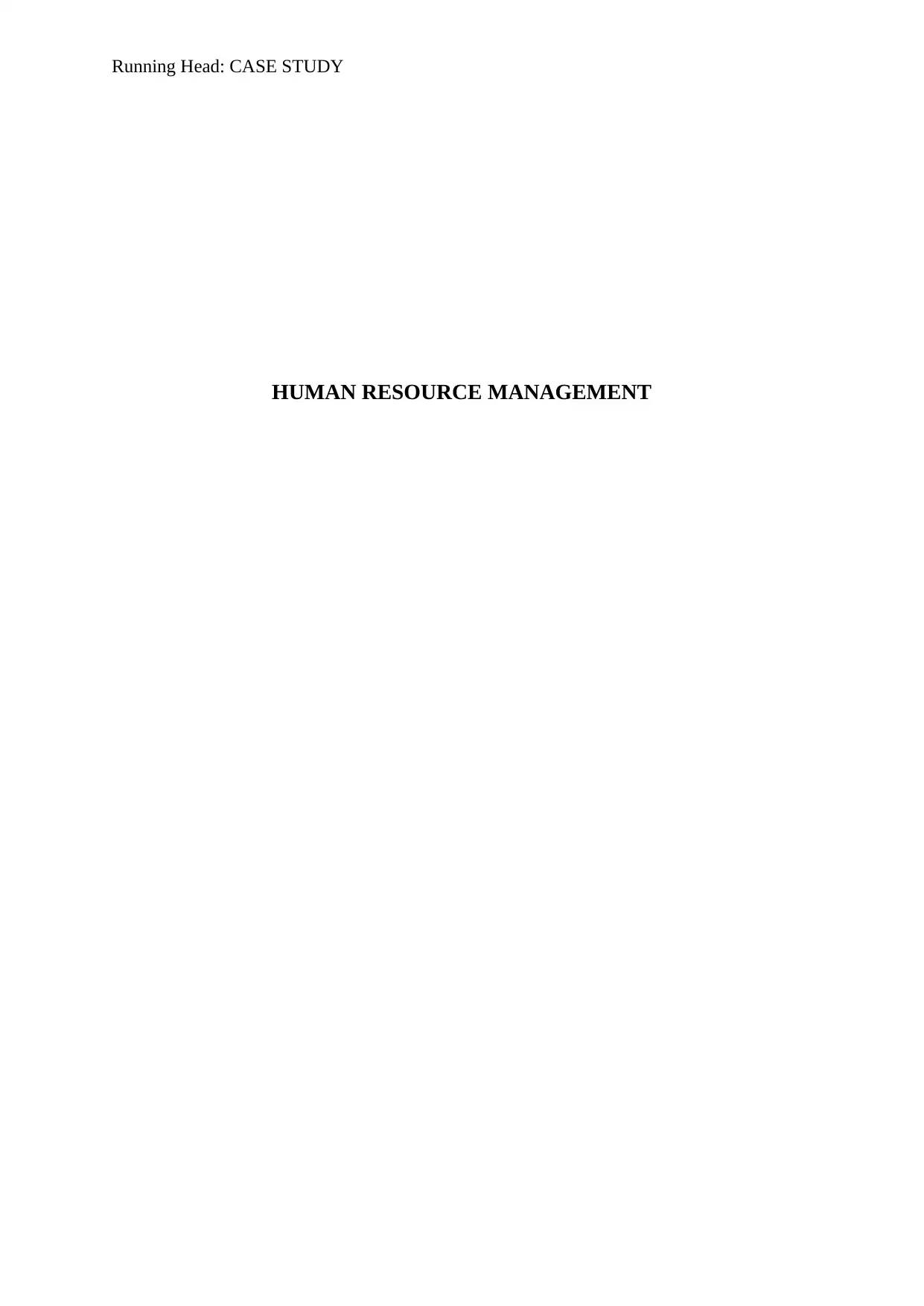
Running Head: CASE STUDY
HUMAN RESOURCE MANAGEMENT
HUMAN RESOURCE MANAGEMENT
Paraphrase This Document
Need a fresh take? Get an instant paraphrase of this document with our AI Paraphraser
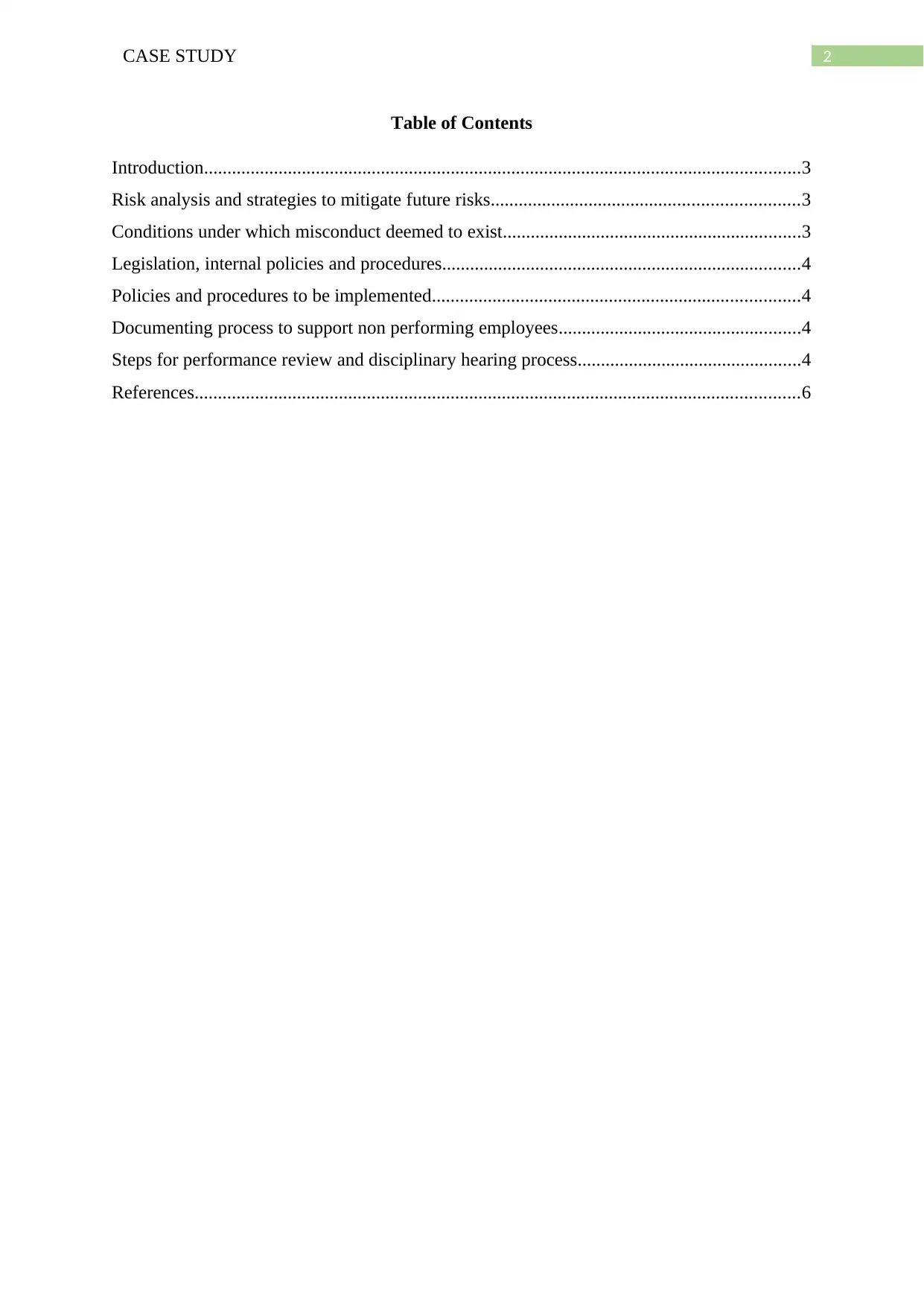
2CASE STUDY
Table of Contents
Introduction................................................................................................................................3
Risk analysis and strategies to mitigate future risks..................................................................3
Conditions under which misconduct deemed to exist................................................................3
Legislation, internal policies and procedures.............................................................................4
Policies and procedures to be implemented...............................................................................4
Documenting process to support non performing employees....................................................4
Steps for performance review and disciplinary hearing process................................................4
References..................................................................................................................................6
Table of Contents
Introduction................................................................................................................................3
Risk analysis and strategies to mitigate future risks..................................................................3
Conditions under which misconduct deemed to exist................................................................3
Legislation, internal policies and procedures.............................................................................4
Policies and procedures to be implemented...............................................................................4
Documenting process to support non performing employees....................................................4
Steps for performance review and disciplinary hearing process................................................4
References..................................................................................................................................6
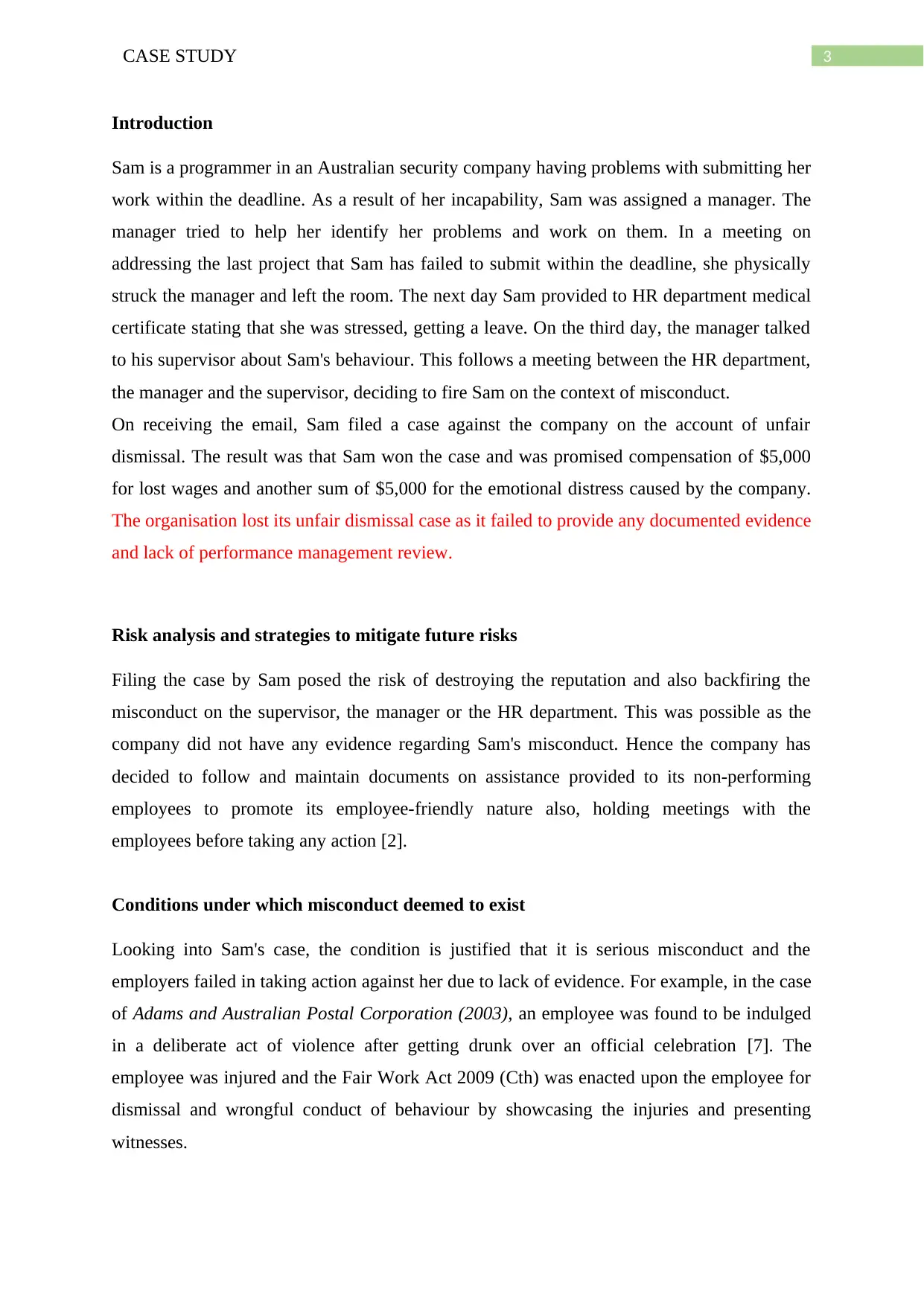
3CASE STUDY
Introduction
Sam is a programmer in an Australian security company having problems with submitting her
work within the deadline. As a result of her incapability, Sam was assigned a manager. The
manager tried to help her identify her problems and work on them. In a meeting on
addressing the last project that Sam has failed to submit within the deadline, she physically
struck the manager and left the room. The next day Sam provided to HR department medical
certificate stating that she was stressed, getting a leave. On the third day, the manager talked
to his supervisor about Sam's behaviour. This follows a meeting between the HR department,
the manager and the supervisor, deciding to fire Sam on the context of misconduct.
On receiving the email, Sam filed a case against the company on the account of unfair
dismissal. The result was that Sam won the case and was promised compensation of $5,000
for lost wages and another sum of $5,000 for the emotional distress caused by the company.
The organisation lost its unfair dismissal case as it failed to provide any documented evidence
and lack of performance management review.
Risk analysis and strategies to mitigate future risks
Filing the case by Sam posed the risk of destroying the reputation and also backfiring the
misconduct on the supervisor, the manager or the HR department. This was possible as the
company did not have any evidence regarding Sam's misconduct. Hence the company has
decided to follow and maintain documents on assistance provided to its non-performing
employees to promote its employee-friendly nature also, holding meetings with the
employees before taking any action [2].
Conditions under which misconduct deemed to exist
Looking into Sam's case, the condition is justified that it is serious misconduct and the
employers failed in taking action against her due to lack of evidence. For example, in the case
of Adams and Australian Postal Corporation (2003), an employee was found to be indulged
in a deliberate act of violence after getting drunk over an official celebration [7]. The
employee was injured and the Fair Work Act 2009 (Cth) was enacted upon the employee for
dismissal and wrongful conduct of behaviour by showcasing the injuries and presenting
witnesses.
Introduction
Sam is a programmer in an Australian security company having problems with submitting her
work within the deadline. As a result of her incapability, Sam was assigned a manager. The
manager tried to help her identify her problems and work on them. In a meeting on
addressing the last project that Sam has failed to submit within the deadline, she physically
struck the manager and left the room. The next day Sam provided to HR department medical
certificate stating that she was stressed, getting a leave. On the third day, the manager talked
to his supervisor about Sam's behaviour. This follows a meeting between the HR department,
the manager and the supervisor, deciding to fire Sam on the context of misconduct.
On receiving the email, Sam filed a case against the company on the account of unfair
dismissal. The result was that Sam won the case and was promised compensation of $5,000
for lost wages and another sum of $5,000 for the emotional distress caused by the company.
The organisation lost its unfair dismissal case as it failed to provide any documented evidence
and lack of performance management review.
Risk analysis and strategies to mitigate future risks
Filing the case by Sam posed the risk of destroying the reputation and also backfiring the
misconduct on the supervisor, the manager or the HR department. This was possible as the
company did not have any evidence regarding Sam's misconduct. Hence the company has
decided to follow and maintain documents on assistance provided to its non-performing
employees to promote its employee-friendly nature also, holding meetings with the
employees before taking any action [2].
Conditions under which misconduct deemed to exist
Looking into Sam's case, the condition is justified that it is serious misconduct and the
employers failed in taking action against her due to lack of evidence. For example, in the case
of Adams and Australian Postal Corporation (2003), an employee was found to be indulged
in a deliberate act of violence after getting drunk over an official celebration [7]. The
employee was injured and the Fair Work Act 2009 (Cth) was enacted upon the employee for
dismissal and wrongful conduct of behaviour by showcasing the injuries and presenting
witnesses.
⊘ This is a preview!⊘
Do you want full access?
Subscribe today to unlock all pages.

Trusted by 1+ million students worldwide
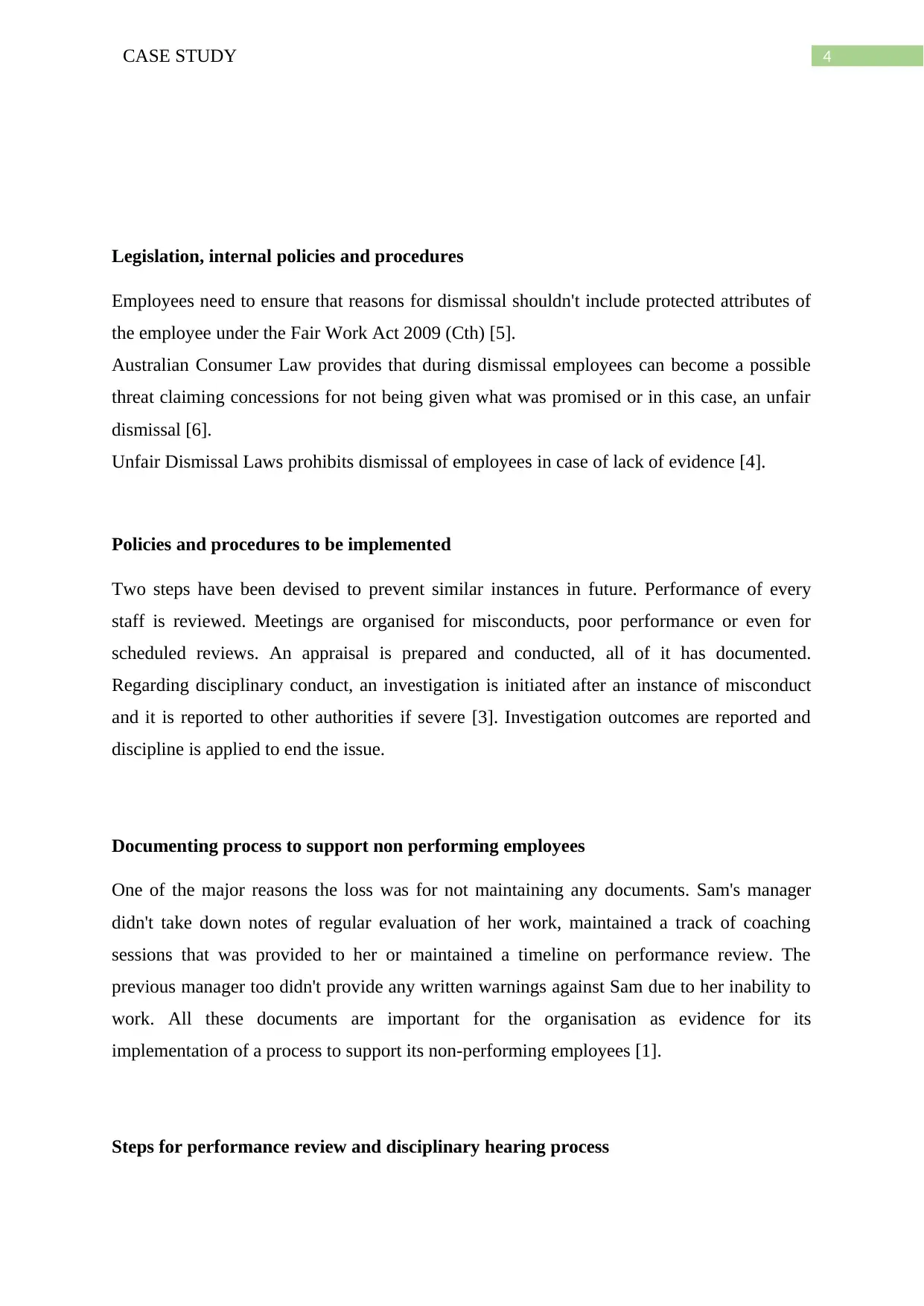
4CASE STUDY
Legislation, internal policies and procedures
Employees need to ensure that reasons for dismissal shouldn't include protected attributes of
the employee under the Fair Work Act 2009 (Cth) [5].
Australian Consumer Law provides that during dismissal employees can become a possible
threat claiming concessions for not being given what was promised or in this case, an unfair
dismissal [6].
Unfair Dismissal Laws prohibits dismissal of employees in case of lack of evidence [4].
Policies and procedures to be implemented
Two steps have been devised to prevent similar instances in future. Performance of every
staff is reviewed. Meetings are organised for misconducts, poor performance or even for
scheduled reviews. An appraisal is prepared and conducted, all of it has documented.
Regarding disciplinary conduct, an investigation is initiated after an instance of misconduct
and it is reported to other authorities if severe [3]. Investigation outcomes are reported and
discipline is applied to end the issue.
Documenting process to support non performing employees
One of the major reasons the loss was for not maintaining any documents. Sam's manager
didn't take down notes of regular evaluation of her work, maintained a track of coaching
sessions that was provided to her or maintained a timeline on performance review. The
previous manager too didn't provide any written warnings against Sam due to her inability to
work. All these documents are important for the organisation as evidence for its
implementation of a process to support its non-performing employees [1].
Steps for performance review and disciplinary hearing process
Legislation, internal policies and procedures
Employees need to ensure that reasons for dismissal shouldn't include protected attributes of
the employee under the Fair Work Act 2009 (Cth) [5].
Australian Consumer Law provides that during dismissal employees can become a possible
threat claiming concessions for not being given what was promised or in this case, an unfair
dismissal [6].
Unfair Dismissal Laws prohibits dismissal of employees in case of lack of evidence [4].
Policies and procedures to be implemented
Two steps have been devised to prevent similar instances in future. Performance of every
staff is reviewed. Meetings are organised for misconducts, poor performance or even for
scheduled reviews. An appraisal is prepared and conducted, all of it has documented.
Regarding disciplinary conduct, an investigation is initiated after an instance of misconduct
and it is reported to other authorities if severe [3]. Investigation outcomes are reported and
discipline is applied to end the issue.
Documenting process to support non performing employees
One of the major reasons the loss was for not maintaining any documents. Sam's manager
didn't take down notes of regular evaluation of her work, maintained a track of coaching
sessions that was provided to her or maintained a timeline on performance review. The
previous manager too didn't provide any written warnings against Sam due to her inability to
work. All these documents are important for the organisation as evidence for its
implementation of a process to support its non-performing employees [1].
Steps for performance review and disciplinary hearing process
Paraphrase This Document
Need a fresh take? Get an instant paraphrase of this document with our AI Paraphraser
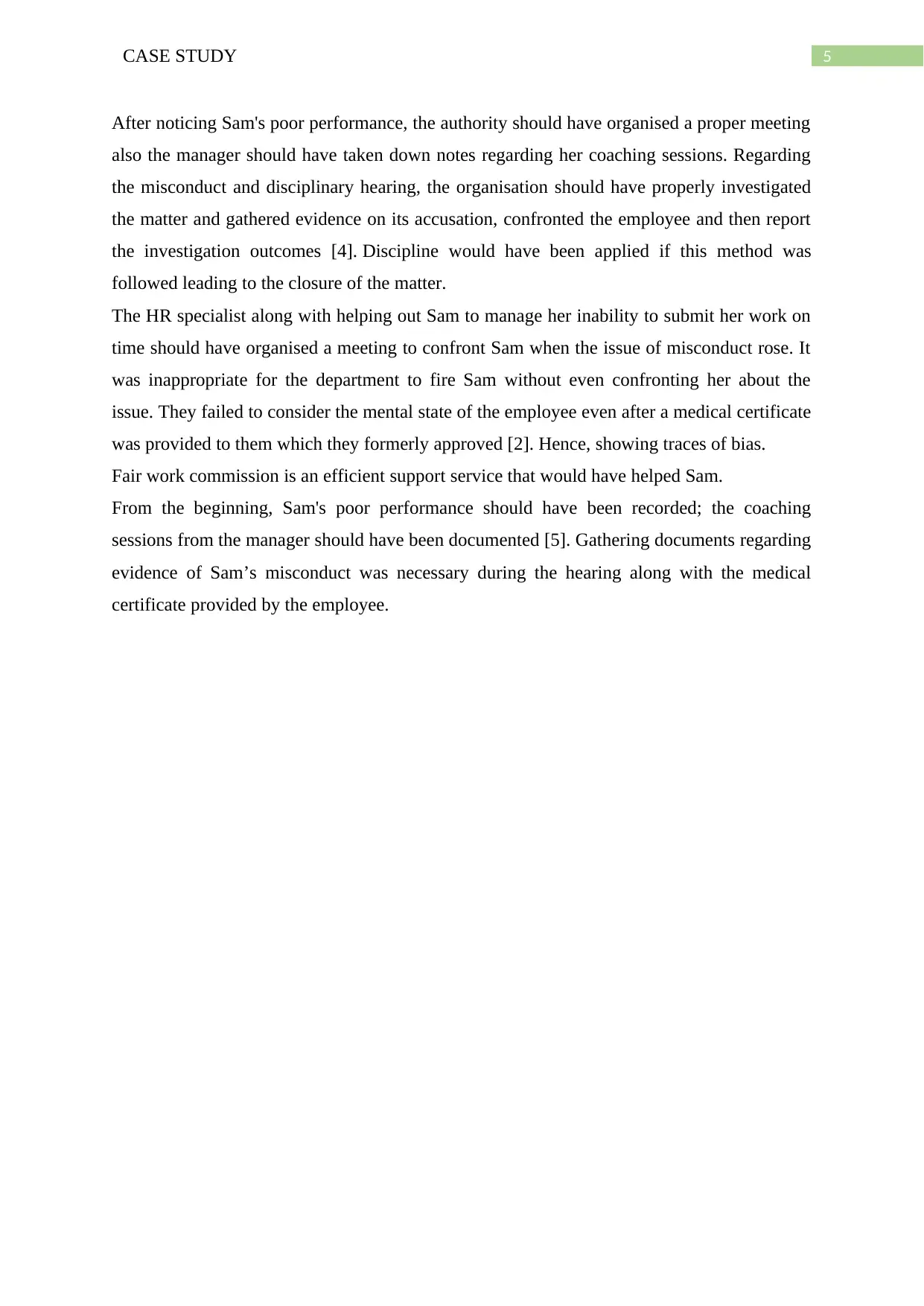
5CASE STUDY
After noticing Sam's poor performance, the authority should have organised a proper meeting
also the manager should have taken down notes regarding her coaching sessions. Regarding
the misconduct and disciplinary hearing, the organisation should have properly investigated
the matter and gathered evidence on its accusation, confronted the employee and then report
the investigation outcomes [4]. Discipline would have been applied if this method was
followed leading to the closure of the matter.
The HR specialist along with helping out Sam to manage her inability to submit her work on
time should have organised a meeting to confront Sam when the issue of misconduct rose. It
was inappropriate for the department to fire Sam without even confronting her about the
issue. They failed to consider the mental state of the employee even after a medical certificate
was provided to them which they formerly approved [2]. Hence, showing traces of bias.
Fair work commission is an efficient support service that would have helped Sam.
From the beginning, Sam's poor performance should have been recorded; the coaching
sessions from the manager should have been documented [5]. Gathering documents regarding
evidence of Sam’s misconduct was necessary during the hearing along with the medical
certificate provided by the employee.
After noticing Sam's poor performance, the authority should have organised a proper meeting
also the manager should have taken down notes regarding her coaching sessions. Regarding
the misconduct and disciplinary hearing, the organisation should have properly investigated
the matter and gathered evidence on its accusation, confronted the employee and then report
the investigation outcomes [4]. Discipline would have been applied if this method was
followed leading to the closure of the matter.
The HR specialist along with helping out Sam to manage her inability to submit her work on
time should have organised a meeting to confront Sam when the issue of misconduct rose. It
was inappropriate for the department to fire Sam without even confronting her about the
issue. They failed to consider the mental state of the employee even after a medical certificate
was provided to them which they formerly approved [2]. Hence, showing traces of bias.
Fair work commission is an efficient support service that would have helped Sam.
From the beginning, Sam's poor performance should have been recorded; the coaching
sessions from the manager should have been documented [5]. Gathering documents regarding
evidence of Sam’s misconduct was necessary during the hearing along with the medical
certificate provided by the employee.
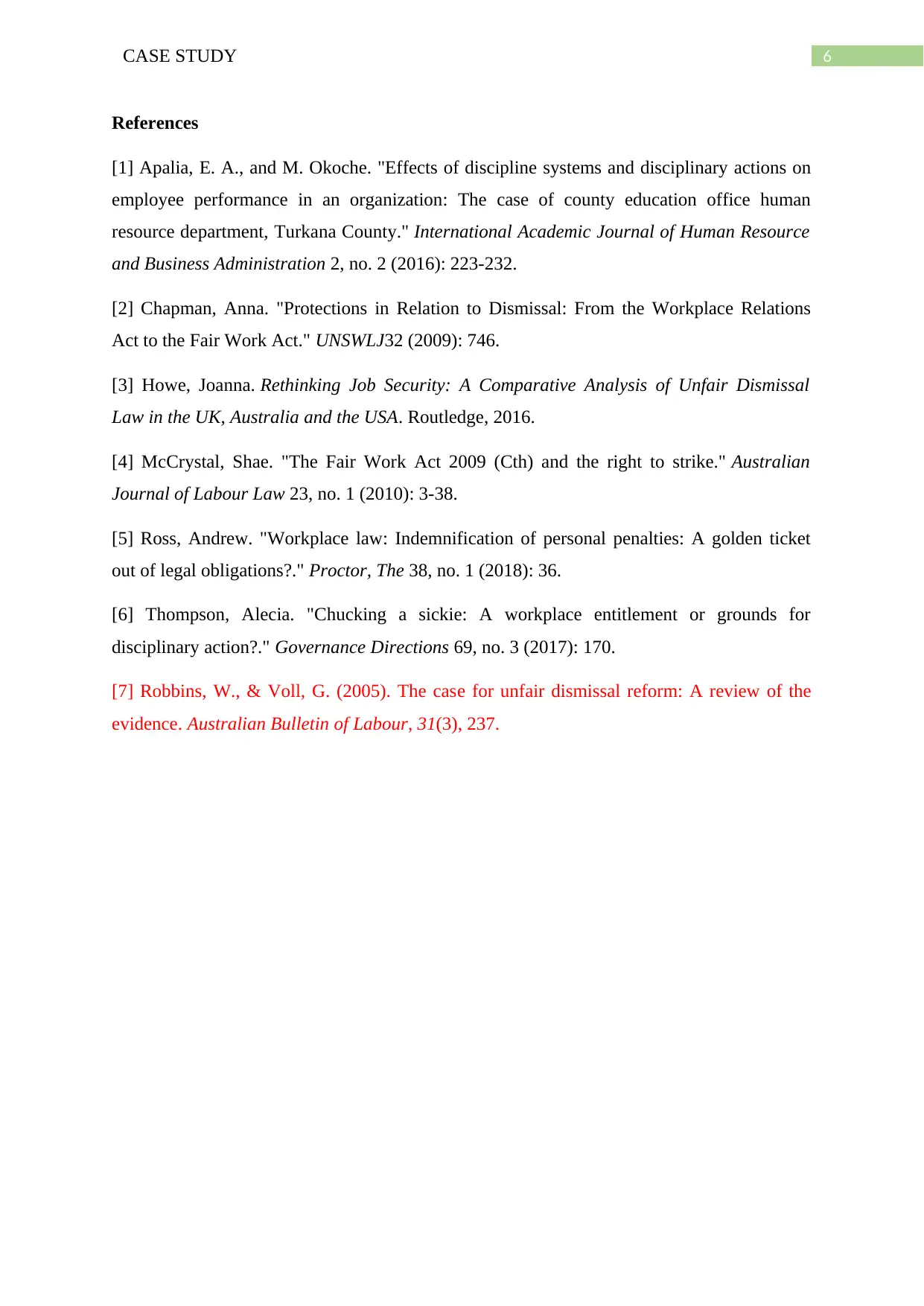
6CASE STUDY
References
[1] Apalia, E. A., and M. Okoche. "Effects of discipline systems and disciplinary actions on
employee performance in an organization: The case of county education office human
resource department, Turkana County." International Academic Journal of Human Resource
and Business Administration 2, no. 2 (2016): 223-232.
[2] Chapman, Anna. "Protections in Relation to Dismissal: From the Workplace Relations
Act to the Fair Work Act." UNSWLJ32 (2009): 746.
[3] Howe, Joanna. Rethinking Job Security: A Comparative Analysis of Unfair Dismissal
Law in the UK, Australia and the USA. Routledge, 2016.
[4] McCrystal, Shae. "The Fair Work Act 2009 (Cth) and the right to strike." Australian
Journal of Labour Law 23, no. 1 (2010): 3-38.
[5] Ross, Andrew. "Workplace law: Indemnification of personal penalties: A golden ticket
out of legal obligations?." Proctor, The 38, no. 1 (2018): 36.
[6] Thompson, Alecia. "Chucking a sickie: A workplace entitlement or grounds for
disciplinary action?." Governance Directions 69, no. 3 (2017): 170.
[7] Robbins, W., & Voll, G. (2005). The case for unfair dismissal reform: A review of the
evidence. Australian Bulletin of Labour, 31(3), 237.
References
[1] Apalia, E. A., and M. Okoche. "Effects of discipline systems and disciplinary actions on
employee performance in an organization: The case of county education office human
resource department, Turkana County." International Academic Journal of Human Resource
and Business Administration 2, no. 2 (2016): 223-232.
[2] Chapman, Anna. "Protections in Relation to Dismissal: From the Workplace Relations
Act to the Fair Work Act." UNSWLJ32 (2009): 746.
[3] Howe, Joanna. Rethinking Job Security: A Comparative Analysis of Unfair Dismissal
Law in the UK, Australia and the USA. Routledge, 2016.
[4] McCrystal, Shae. "The Fair Work Act 2009 (Cth) and the right to strike." Australian
Journal of Labour Law 23, no. 1 (2010): 3-38.
[5] Ross, Andrew. "Workplace law: Indemnification of personal penalties: A golden ticket
out of legal obligations?." Proctor, The 38, no. 1 (2018): 36.
[6] Thompson, Alecia. "Chucking a sickie: A workplace entitlement or grounds for
disciplinary action?." Governance Directions 69, no. 3 (2017): 170.
[7] Robbins, W., & Voll, G. (2005). The case for unfair dismissal reform: A review of the
evidence. Australian Bulletin of Labour, 31(3), 237.
⊘ This is a preview!⊘
Do you want full access?
Subscribe today to unlock all pages.

Trusted by 1+ million students worldwide
1 out of 6
Your All-in-One AI-Powered Toolkit for Academic Success.
+13062052269
info@desklib.com
Available 24*7 on WhatsApp / Email
![[object Object]](/_next/static/media/star-bottom.7253800d.svg)
Unlock your academic potential
Copyright © 2020–2025 A2Z Services. All Rights Reserved. Developed and managed by ZUCOL.


